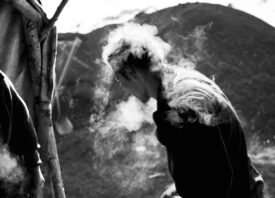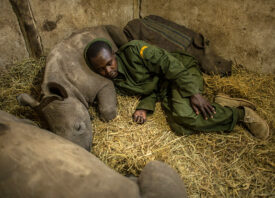Search this site
The Destruction of the Amazon in Photos


The destruction of the planet at the hands of imperialist forces bears out Biblical prophecies of Armageddon, though what we are witnessing today was a long time coming. “The Europeans arrived from the east like a disastrous tsunami, draining the sap from the trees, the soil… even from human beings,” writes archaeologist Stéphen Rostain in the preface to AMAZÔNIA: Life and Death in the Brazilian Rainforest (Fondation Carmignac and Reliefs Editions) by Tommaso Protti. The work is now on view at Maison Européenne de la Photographie in Paris through February 16, 2020.
Rostain continues: “In order to be seen by the world, the Amerindians nearly disappeared: between 80 and 95% of the original population of Amazonia died out as a result of the conquest, before making a lifesaving recovery and rebelling against their condition. In the Amazon, people are being persecuted, deforestation has never been so virulent, biodiversity is dropping drastically, the earth is dying and so is the water.”

We have been led precipice of global collapse by the descendants of those who see the earth and its inhabitants as a limitless resource to oppress and exploit, pathologically overconfident in their belief that what their crimes against the planet will allow them entry to the gates of heaven — while the rest of us acknowledge that this enterprise is nothing but a highway to hell.
While leadership shrouds itself with climate change denial, the planet deteriorates at an exponential rate, forcing us to recognize change will not come from the top. We must educate ourselves and prioritize health above all things by diagnosing the problems and working towards viable solutions.
Italian photographer Tommaso Protti is doing just that. As recipient of the 10th Carmignac Photojournalism Award, which funds annually the production of an investigative photo reportage on human rights violations, and geostrategic issues in the world, Protti teamed up with British journalist Sam Cowie to travel thousands of miles through the Brazilian Amazon between January and July of last year to examine the interrelationship between the social, humanitarian, and ecological crises decimating the region.

Up against the ongoing threat of BBB (Bible, Bullets, and Beef), the Amazon and all life it supports — beyond the actual terrain — is systematically being laid to waste. “Tommaso Protti recounts the rape of the Amazon. There is plenty to see: illegal gold mines gnawing voraciously into the subsoil, jungle cemeteries where stranded trees form tombstone crosses, abject killings to steal a few acres of land or a pinch of drugs, unhealthy favelas burned by devastating fires, scenes of drunkenness, prostitution or cocaine-laced insanity in the heat of these tropical mean streets,” Rostain writes.
“The photographer has taken his camera into the deepest, darkest corners of Amazonia to capture uncompromising testimonies: a forester crying over a fallen tree; a gold digger, his fingers gnawed away by his fever for the metal; a little girl lost after her homeland has been flooded by a hydro-electric dam; a drug dealer arrested in the middle of an interview… and down-and-outs everywhere.”
Between deforestation, illegal logging, land grabbing, agricultural expansion, state and private sector led development, and resource extradition projects, we have reached the point of no return. Protti’s photographs offer a gripping look at daily life in the Amazon, revealing how the environmental crisis lies at the intersection of neoliberal policy, predicated on centuries of violence against the people and the land. We watch in horror as we pass the tipping point, the scope of the devastation so vast and the power structure so deadly that we can only gaze in horror at the scale and scope of the violence being done to the people and the earth.



All images: © Tommaso Protti for Fondation Carmignac



